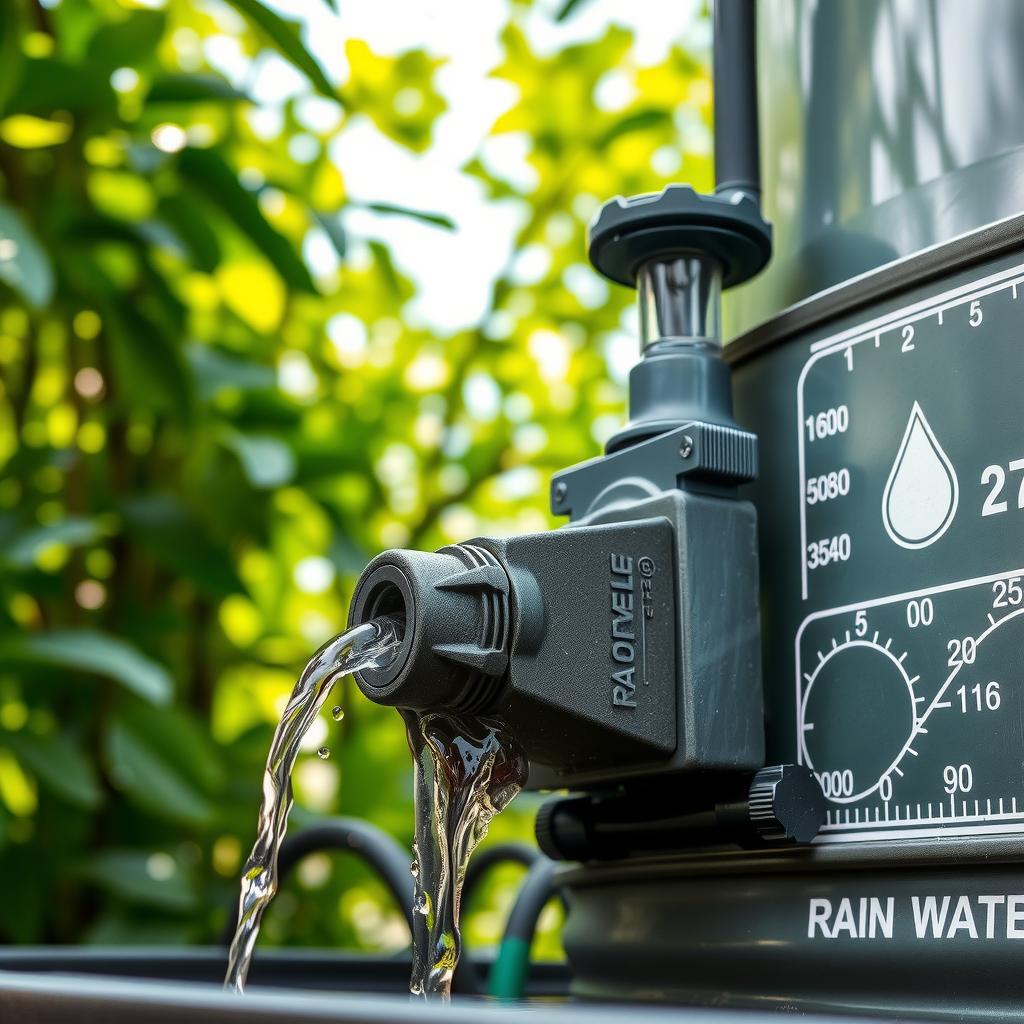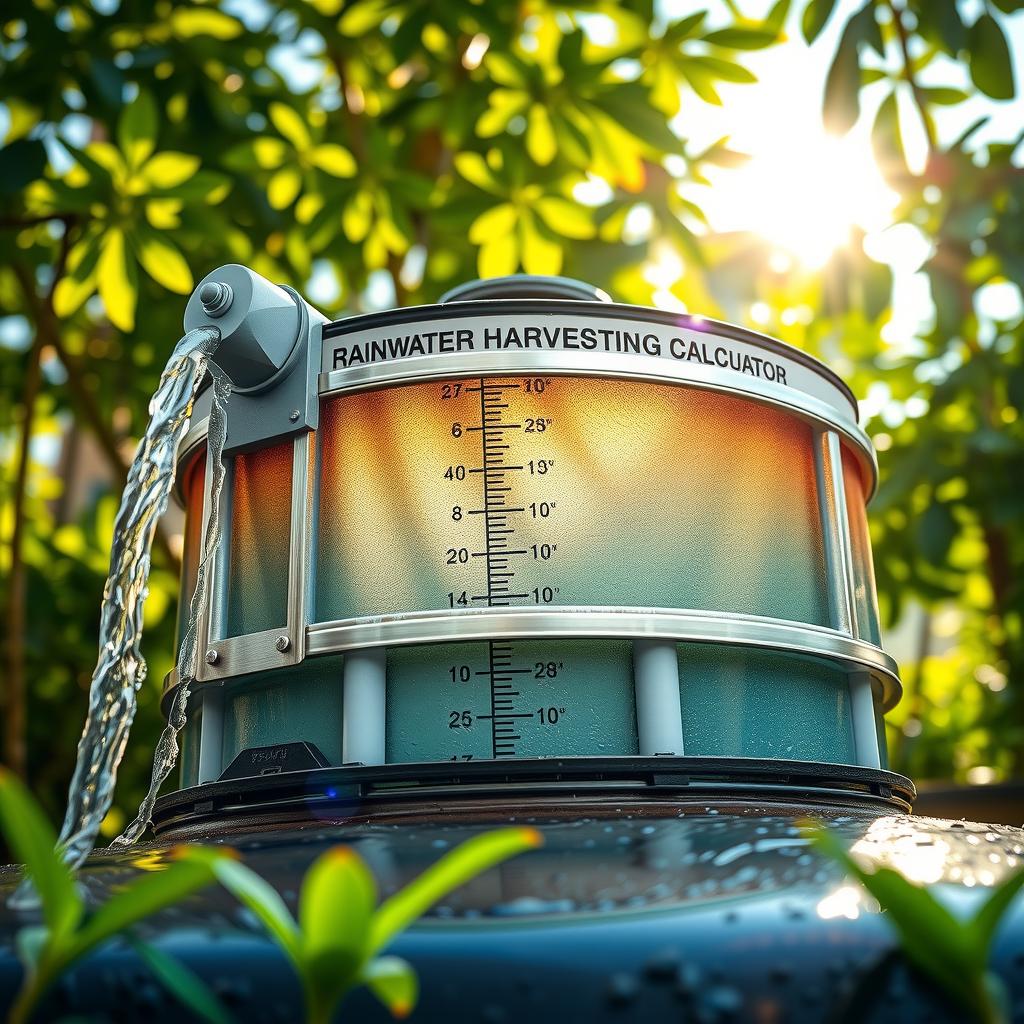As concerns about water scarcity and environmental degradation continue to escalate, many individuals and communities are exploring innovative ways to conserve precious resources. One such solution gaining traction is rainwater harvesting—a sustainable practice that not only reduces dependence on municipal water supply but also plays a crucial role in environmental conservation. However, one of the most pressing questions arises: How do you determine the appropriate size for a rainwater harvesting tank? This is where the Rainwater Harvesting Tank Size Calculator comes into play.
Selecting the right size tank is vital for maximizing efficiency in rainwater collection and ensuring that your system meets both current and future needs. An improperly sized tank can lead to either wasted capacity or insufficient storage during dry spells, undermining the very purpose of your water conservation efforts. By using a reliable tank size calculator, users can bridge this gap between intention and implementation effectively.
The core value of employing such calculators lies in their ability to provide tailored solutions based on specific parameters like local rainfall patterns, roof area, and intended use—be it garden irrigation or household consumption. These calculators empower users with data-driven insights that align with sustainable practices while addressing individual circumstances. Imagine transforming your rooftops into productive sources of clean water!
In this article, readers will discover how utilizing a rainwater harvesting tank size calculator can streamline their journey toward efficient water storage solutions while positively impacting their environment. By optimizing rainwater collection strategies through informed decision-making, individuals can participate actively in mitigating challenges posed by climate change and resource depletion.
Join us as we delve deeper into understanding how these invaluable tools work and why they are essential for anyone considering adopting rainwater harvesting systems—because every drop counts when it comes to conserving our planet’s most vital resource!

Key points:
-
Understanding Rainwater Collection Needs: Assessing individual requirements is vital for effective rainwater harvesting. By utilizing the Rainwater harvesting tank size calculator, homeowners can input their specific roof area and average rainfall data, allowing for a tailored approach to water storage solutions.
-
Optimizing Tank Size for Garden Irrigation: For those interested in using harvested rainwater for garden irrigation, selecting the appropriate tank size is crucial. The Rainwater harvesting tank size calculator enables users to determine how much water they need based on their landscape’s demand, ensuring efficient use of resources while avoiding overspending on unnecessarily large tanks.
-
Promoting Sustainable Practices through Effective Management: The implementation of proper rainwater collection methods significantly contributes to sustainable living practices. By leveraging the insights provided by the Rainwater harvesting tank size calculator, individuals can minimize their environmental impact and enhance their water conservation efforts, fostering responsible management within their communities.

The Growing Need for Rainwater Harvesting
Addressing Water Scarcity through Innovative Solutions
In an era marked by increasing water scarcity, rainwater harvesting has emerged as a crucial sustainable practice aimed at enhancing water conservation. This innovative approach involves the collection and storage of rainwater for various uses, contributing significantly to environmental sustainability. As urban areas expand and populations grow, traditional sources of freshwater are increasingly strained. According to the United Nations, nearly 2 billion people live in countries experiencing high water stress; thus, implementing effective water storage solutions becomes imperative. The rainwater harvesting tank size calculator serves as a valuable tool for individuals and communities looking to optimize their systems based on specific rainfall patterns and usage needs.
Benefits of Rainwater Collection
Rainwater collection not only alleviates pressure on existing water supplies but also promotes self-sufficiency among households and businesses. By utilizing harvested rainwater for irrigation or non-potable purposes like toilet flushing, users can significantly reduce dependence on municipal water systems. For instance, garden irrigation benefits immensely from this method; plants thrive with natural rainfall compared to treated tap water enriched with chemicals. Moreover, collecting rain reduces runoff that can lead to flooding while simultaneously decreasing soil erosion—an often-overlooked environmental impact associated with conventional drainage systems.
Environmental Impact of Sustainable Practices
The integration of sustainable practices such as rainwater harvesting is pivotal in mitigating climate change effects and promoting ecological balance. When implemented widely across communities, these practices foster resilience against drought conditions prevalent in many regions worldwide today. Additionally, the use of rainwater harvesting tank size calculators allows stakeholders—from homeowners to municipalities—to assess their needs accurately while considering local climatic variations that affect precipitation levels throughout the year.
Implementing Effective Water Storage Solutions
For successful implementation of rainwater harvesting strategies, it is essential first to evaluate potential sites where collection infrastructure can be established effectively—rooftops being prime candidates due to their surface area exposure during rainfall events. Subsequently determining appropriate system sizes via a reliable tank size calculator ensures adequate storage without overestimating capacity or incurring unnecessary expenses related to excess infrastructure development.
Future Perspectives: Towards a Water-Conscious Society
As society progresses towards more sustainable living standards amid escalating global challenges concerning resource management—including diminishing freshwater availability—the role of initiatives focused on enhancing public awareness about efficient methods such as rainwater harvesting cannot be understated. Educational programs highlighting its advantages alongside user-friendly tools like the rainfall tank size calculator will empower individuals toward adopting these eco-friendly alternatives within their daily routines effectively fostering community-wide engagement aimed at long-term sustainability goals.

Understanding the Basics of Rainwater Harvesting Tank Size Calculation
The Importance of Accurate Measurements for Effective Water Conservation
In the realm of sustainable practices, utilizing a rainwater harvesting tank size calculator is essential for optimizing water collection systems. This tool assists individuals and organizations in determining the appropriate tank size based on specific parameters such as roof area and average rainfall. To begin, users must first measure their roof area—this is typically done by calculating the total square footage of all surfaces that will channel rainwater into your system. For instance, if a home has a gabled roof with two equal planes measuring 30 feet by 20 feet each, this yields an effective catchment area crucial for accurate calculations.
Next, it’s vital to gather data on local climate conditions; specifically, understanding regional average rainfall figures plays a significant role in maximizing efficiency. These statistics can be sourced from meteorological databases or local government reports to ensure accuracy. Once you have both measurements at hand—the roof area and average annual precipitation—you can input these values into the rainwater harvesting tank size calculator. The calculator typically employs formulas that factor in runoff coefficients (which adjust theoretical rainfall based on surface type) to provide an estimate of how much water you can expect to collect over time.
Furthermore, when using this tool, it’s beneficial to consider additional factors like intended usage for stored water—whether it’s primarily for garden irrigation or household use—as this influences storage capacity recommendations significantly. By tailoring your approach according to personal needs while utilizing the rainwater harvesting tank size calculator, one not only ensures adequate supply but also enhances overall environmental impact through effective water conservation measures.
Maximizing Efficiency: Integrating Design with Functionality
Utilizing a well-calibrated rainwater harvesting tank size calculator goes beyond mere numbers; it harmonizes design principles with functional requirements tailored toward efficient rainwater collection systems. When planning your setup, consider incorporating features such as sedimentation tanks or filtration systems which enhance quality before storage—a critical step toward ensuring safe usability when drawing from stored reserves.
Moreover, placement matters immensely; positioning tanks close to downspouts minimizes potential losses during transfer and maximizes yield efficiency derived from even minimal rainfall events throughout dry seasons or drought periods common in certain climates.
To illustrate further: imagine calculating your ideal system yields approximately 1,500 gallons per year based solely on seasonal averages yet implementing strategic enhancements could potentially double that figure via improved designs aimed at reducing evaporation losses during hotter months while ensuring longer-term viability amidst fluctuating weather patterns due climatic changes seen globally today.
Ultimately marrying aesthetic considerations alongside functionality lays foundational groundwork upon which sustainable practices flourish within communities striving towards greener futures—all made simpler through adept use of tools like our featured rainwater harvesting tank size calculator designed explicitly around fostering better stewardship over precious resources available naturally around us every season anew!
Addressing Common Misconceptions About Rain Barrel Systems
Many misconceptions surround rain barrel systems utilized alongside comprehensive strategies involving larger-scale installations guided by insights gleaned from employing technologies such as our highlighted Rainwater Harvesting Tank Size Calculator. A prevalent myth suggests these setups are only suitable for rural areas; however modern urban dwellings equally benefit immensely where space permits proper configurations encouraging effective drainage management techniques integrated seamlessly without compromising existing aesthetics present therein already established landscapes surrounding homes themselves visibly enhanced further still benefiting city dwellers too!
Additionally some believe capturing excess storm runoff leads inevitably towards increased flooding risks downstream—but conversely properly maintained collections mitigate those dangers altogether empowering residents against potential damages resulting from severe weather events becoming more frequent owing recent climate shifts noted across diverse locales worldwide! Henceforth engaging proactively promotes holistic community resilience efforts ultimately leading positive outcomes enhancing overall quality life experienced day-to-day whilst minimizing adverse effects associated rapid development often observed surrounding metropolitan centers alike anywhere new growth occurs necessitating thoughtful consideration placed strategically whenever tackling challenges posed sustainability across societies actively investing energy resourcefully enough make meaningful change happen gradually evolving cultures thoughts centered preservation future generations inheriting world shaped choices made collectively now together moving forward onward!
Maximizing Efficiency with Your Rainwater System
Tailoring Storage Solutions to Your Needs
Selecting the optimal tank size for a rainwater harvesting system is crucial for maximizing efficiency and achieving cost-effectiveness. A well-planned water storage solution not only conserves valuable resources but also aligns with sustainable practices that benefit both the environment and individual households. When considering how much rainwater to collect, one must first assess their specific usage requirements, which can vary significantly based on factors like household size, garden irrigation needs, and local rainfall patterns. The rainwater harvesting tank size calculator serves as an indispensable tool in this decision-making process. By inputting data such as average monthly rainfall and anticipated water usage, individuals can accurately determine the most suitable tank capacity tailored to their lifestyle.
Understanding the relationship between collected rainwater and its intended use is fundamental for effective water conservation. For instance, families who engage in extensive gardening may require larger tanks to ensure adequate supply during dry spells. Conversely, urban dwellers with minimal outdoor space might opt for smaller tanks that still meet essential indoor needs without overwhelming available area. This balance is vital; overestimating tank size not only leads to unnecessary costs but may also result in inefficient allocation of space within one’s property.
Additionally, evaluating seasonal variations plays a significant role in determining appropriate storage solutions. Regions experiencing heavy rains during certain months should consider larger capacities that allow them to capture surplus water effectively while reducing environmental impact through runoff management strategies. On the other hand, areas with more consistent yet lighter precipitation patterns might find smaller systems sufficient when guided by insights from a rainwater harvesting tank size calculator.
Moreover, integrating smart technology into these systems enhances overall functionality—offering real-time monitoring of stored volumes and automating distribution according to plant watering schedules or household consumption peaks contributes further to efficient resource management. These innovations support sustainable living by minimizing waste while ensuring reliable access throughout varying weather conditions.
In summary, choosing the right storage solutions involves thoughtful consideration of personal habits combined with effective tools such as the rainwater harvesting tank size calculator which guides users towards informed decisions about their collection capacity based on unique circumstances—thus promoting both economic viability and environmentally responsible practices.
Understanding Your Water Collection Needs
Aligning Tank Size With Usage Requirements
Determining how much rainwater one needs depends significantly on daily activities related to home maintenance and landscaping efforts; hence understanding these demands is key when selecting an optimal water storage solution through tools like a rainwater harvesting tank size calculator. Households focused primarily on potable uses will have different requirements than those utilizing harvested water predominantly for irrigation purposes or cleaning tasks outside their homes; thus it’s critical each homeowner reflects upon individual consumption habits before committing resources toward installation infrastructure.
For example: If gardening constitutes 40% or more of total expected use—and especially if there are high-water-demand plants involved—it becomes evident why investing in considerable reservoir capabilities would be prudent long-term strategy despite higher upfront costs associated compared against smaller alternatives aimed solely at occasional upkeep endeavors where less volume suffices adequately instead! Conversely speaking: Smaller yards equipped merely enough provide supplemental hydration rather than full reliance could suffice nicely without taking up too much physical footprint onsite either!
Furthermore analyzing climatic trends provides insight regarding seasonality shifts influencing actual availability/requirement ratios across varying timescales ensures preparedness against potential droughts experienced later down line! Employing comprehensive evaluations alongside intuitive calculation methodologies offered via platforms presenting accessible interfaces reinforces proactive approaches yielding fruitful outcomes ultimately satisfying all stakeholders’ desires simultaneously throughout entire utilization lifecycles ahead!
Determining the ideal size for a rainwater harvesting tank is essential for maximizing water conservation efforts. The Rainwater harvesting tank size calculator provides users with an invaluable tool to accurately assess their specific needs based on various factors. By inputting data such as roof area and average rainfall, individuals can receive tailored recommendations that help them create effective water storage solutions. This systematic approach not only simplifies the decision-making process but also ensures that homeowners can efficiently manage their rainwater collection without oversizing tanks unnecessarily.
Moreover, understanding the intended use of collected rainwater plays a crucial role in determining tank size. For example, those interested in using harvested rainwater for garden irrigation will find that the Rainwater harvesting tank size calculator allows them to gauge how much water they need based on plant types and landscape requirements. With precise calculations at hand, users can optimize both space and cost efficiency while ensuring adequate supply for their gardening endeavors—promoting sustainable practices within their communities.
As concerns about environmental impact grow, utilizing tools like the Rainwater harvesting tank size calculator becomes increasingly important. Homeowners who effectively manage their rainwater collection contribute positively to responsible water management by reducing reliance on municipal sources and minimizing runoff pollution. Through strategic planning enabled by this handy tool, individuals can take proactive steps toward achieving efficient water storage solutions that not only benefit themselves but also foster a culture of sustainability in their neighborhoods.
FAQ:
Q: How do I determine my roof area for calculating tank size?
A: Measure your roof’s length and width; multiply these dimensions together to find the total square footage of your roof area for accurate input into the Rainwater harvesting tank size calculator.
Q: Can I use harvested rainwater for household consumption?
A: Yes, however it is crucial to ensure proper filtration and treatment before using harvested rainwater from your system; consult local regulations regarding safety standards when implementing this with insights from the Rainwater harvesting tank size calculator.
Q: What if my region has variable rainfall throughout the year?
A: The Rainwater harvesting tank size calculator takes average rainfall data into account; consider consulting historical weather patterns or local meteorological services to input accurate figures reflecting seasonal variations.
